LUSAS Bridge LT
LUSAS Bridge
LT provides quick and easy to use linear
static analysis using 2D/3D structural beams and grillages.
The LT
version will be of particular interest to companies wishing to
standardise and expand on their use of LUSAS software throughout their
organisation, and together with the Standard and Plus versions, provides a ‘one
stop solution’ for all your analysis requirements.
Because all levels of the products
use the same user interface and terminology, training costs can be
minimised and users can be introduced to LUSAS at the most appropriate
level for the work they need to do. There is also full data
compatibility across the product range allowing easy migration of a
model to a more advanced analysis when required without any data
conversion or remodelling.
Modelling
- The LT version uses the same
associative Modeller for modelling and results processing as the
Standard and Plus versions making upgrading to these higher versions
very straightforward.
- The simplified LT user interface will help you
to build your models faster.
- Startup templates are provided for
grillage, 2D and 3D beam analysis, with line mesh and simple support
data being pre-loaded into the Attributes Treeview.
- Models are created
using point and line features, and wizards are provided for specific
applications.
- Tapered beam sections can be defined.
- Additional model
attributes such as supports, loadings, materials, etc. can be named
explicitly, and once created are displayed in the Treeview for
subsequent assigning to selected geometry of the model using the
"drag and drop" technique.
- Built-in associativity ensures
that if the model geometry is amended, all assigned loadings, supports
and other attributes are automatically moved to suit.
- Fleshing (the
visualisation of any assigned geometric properties) helps ensure that
the orientations of beam members are correctly defined.
- A multi-level
undo/redo facility allows quick modelling corrections to be made.
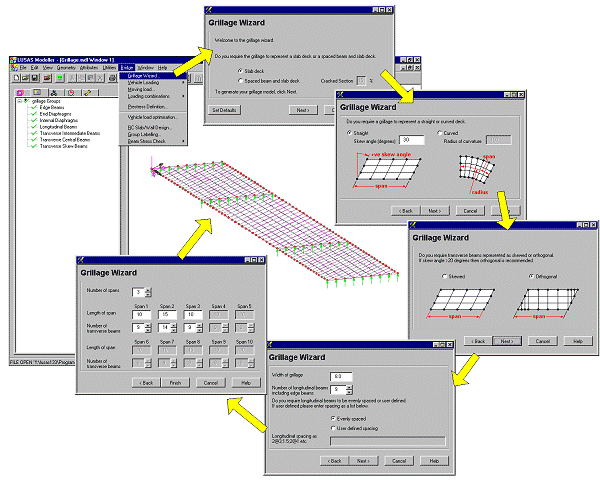
Section
and material libraries
- Libraries of section properties
are provided for UK, US, EU, Korean, Australian and Canadian
steel sections.
- A standard section property calculator enables
section properties for similar shapes to be calculated.
- Basic
engineering properties for bar and beams can also be manually
entered.
- A library of common material properties is included and
others can be user-defined.
|
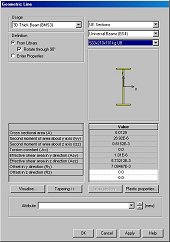
|
Layers and
Windows
- Models are formed of layers where
the visibility and properties of each layer can be controlled
and accessed via the layer name which is held in the Treeview.
-
As the model is built up, model features may be grouped together
and manipulated to speed up data preparation or to enable parts
of the model to be temporarily hidden.
- This LT version supports a
single graphical window for viewing the model and results.
- An
OpenGL implementation allows for fast hardware or software
generated graphical displays.
- Powerful cursor selection, full
pan and zoom and dynamic rotation allow for easy viewing and
manipulation of your model.
|
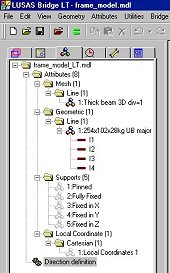 |
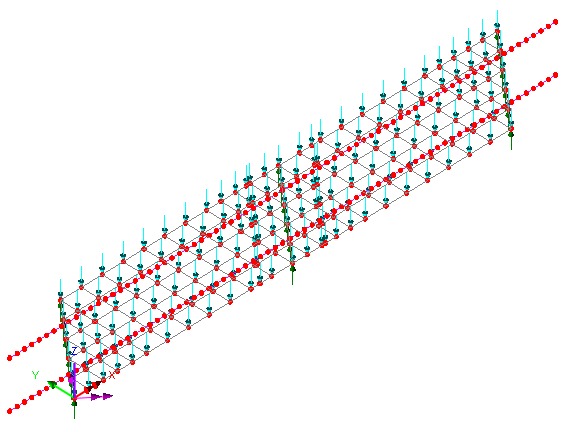
Loading
- For general use, concentrated, body
force, global and local distributed, face, temperature, and internal
beam loading is provided.
- Prescribed loading allows initial
displacements to be defined. Discrete loads can be used to distribute
point and patch over full or partial areas of the model, independent
of the model geometry.
- For bridge analysis, comprehensive static
vehicle, lane, and knife edge loading types are provided for many
regional codes of practice. These currently include: AASHTO LFD &
LRFD (USA), BD21/97 (UK), 21/01 (UK), BD37/88 (UK), 37/01 (UK), BRO94
and BRO2002 Vehicle and Classification loads and BRO Train loading
(Sweden), Korean, Israel, Norway, and HK (Hong Kong), Australia,
China, Eurocode vehicle and train loading, Finland, India, New Zealand
and Poland. Additional static loading types are being added all the
time.
- A moving vehicle load facility is provided to enable these
static loads to be passed across a structure.
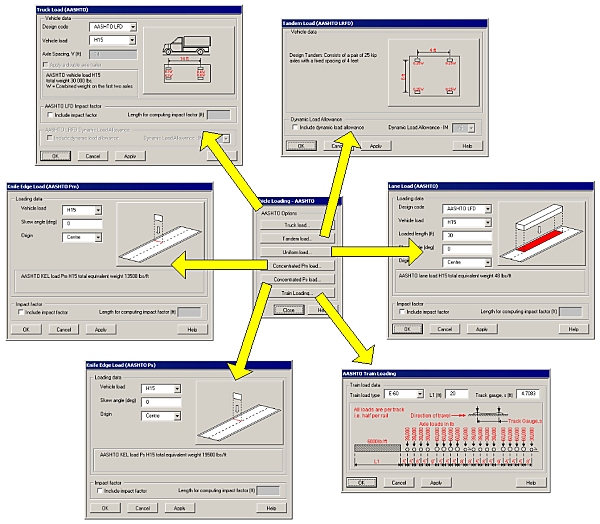
Load combinations
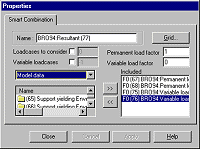 Basic and Smart load combination
facilities are a key feature of all LUSAS Bridge products and allow manual or fully automated assembly of
design load combinations. Basic and Smart load combination
facilities are a key feature of all LUSAS Bridge products and allow manual or fully automated assembly of
design load combinations. - Using Basic and Smart load
combinations envelopes, contour and deflected
shape plots, and results graphs can be readily obtained for any
loadcase or combination of loadcases under consideration.
- Basic load
combinations allow for manual definition of loadcases and load
factors.
- The Smart Combinations facility automatically generates
maximum and minimum load combinations from the applied loadings to
take account of adverse and relieving effects - saving time and
reducing the chance of errors.
Viewing results
- The LUSAS LT version supports a single results
viewing window that can hold a number of predefined results layers.
After selecting a loadcase, results are viewed using separate layers
for contour, diagram, deformed mesh, vector and discrete value data.
-
Diagrams of bending moments and shear forces can be displayed on
deformed or undeformed fleshed or unfleshed members.
- Beam stresses can
be plotted at specified fibre locations.
- An animation wizard can show
how a structure deforms from an un-deformed shape to its loaded
deformed shape.
- A graph wizard provides a way of investigating the
change of bending moment at a node for a sequence of moving loadcases.
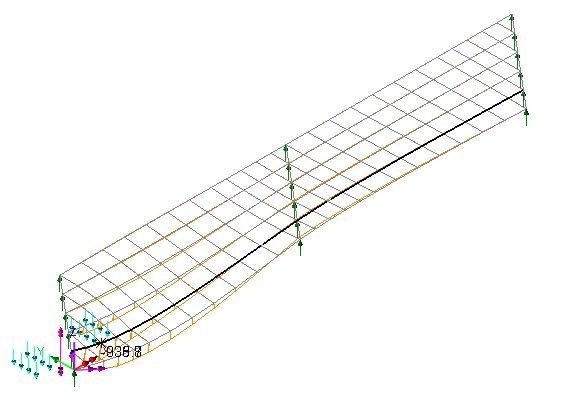
Saving and printing
results
- Views of your LUSAS model may be
printed directly to your default printer from page layout or working
mode and a printing scale and origin can be defined.
- Model views can
also be copied in high resolution for pasting into other applications.
-
A report wizard allows model and results data to be selected on an
element, feature type, group, and loadcase basis for output into
various formats (including MS Word .DOC format) for model checking and
quality assurance purposes.
Output to 3rd party
software
- The contents of a model window can be
saved or copied for use in creating reports in applications such as MS
Word.
- All results can be output for use in spreadsheet applications
such as MS Excel where additional graphing or calculations can be
carried out.
Compatibility with
other LUSAS software
- Model and results files created by
LUSAS LT versions can be read by other LUSAS Bridge or LUSAS Civil
& Structural software products.
- Model and results files created by
Standard and Plus versions can be opened for editing and viewing in
LUSAS LT provided the model contains only those elements supported by
the LT version.
Software
specification
Find out more
|
|
Software Information
|